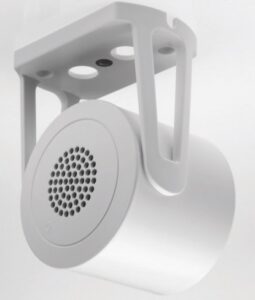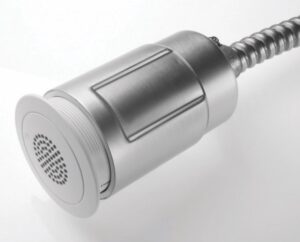News
18 Jun 2019
Sound Masking 101

Subscribe to CX E-News
BUSINESS
Sound Masking 101
Presented by Cambridge Sound Management
Sound Masking is a Critical Component of Acoustic Design
When designing an optimal acoustic environment, architects consider a variety of elements to address noise control and speech privacy. Elements added either Absorb, Block, or Cover sound, and are collectively called the ABC’s of acoustic design.
Absorb: Acoustic wall panels, carpet, and ceiling tiles help absorb excess sound
Block: Solid barriers, partitions, and walls help block excess sound
Cover: Sound masking helps cover up excess sound
All of the ABC’s of acoustic design can be used together or individually to achieve the desired acoustic environment, but absorbing and blocking materials are costly and underused. Sound masking, on the other hand, is a low-cost option for creating acoustical environments that both reduce noise distractions and increase speech privacy.
 Why Do You Need Sound Masking?
Why Do You Need Sound Masking?
Open Floor Plans are the New Normal
Most workplaces today feature more open spaces and smaller, and often shared, workstations. Fewer sound blocking and absorptive materials are being used such as lower or non-existent partitions, hard or glass surfaces, and thinner walls and doors.
This creates acoustical challenges that negatively impact workplace satisfaction, productivity, and speech privacy.
Sound Masking Increases Worker Satisfaction
Approximately 24,000 office workers in private offices, shared offices, cubicles, and open offices were asked to rate their satisfaction with their noise and speech privacy levels. Those with private offices were the only ones satisfied with their speech privacy, and even they only rated them a .55 out of 2 on average.
As you can see, cubicle and open office employees were notably dissatisfied with their office’s levels of speech privacy.
Lack of Speech Privacy is the Number One Concern of Employees
What’s speech privacy? Simply put, it’s the inability of an unintended listener to understand outside conversations. So someone with a lack of speech privacy is overhearing lots of conversations they shouldn’t be and is also concerned that their conversation is being overheard by others.
The chart below says it all. The Center for the Built Environment in Berkeley, California, surveyed more than 25,000 workers in more than 2,000 buildings to determine what the key environmental issues were for workers.
Of all of the factors workers encountered in their environment, speech privacy was far and away the factor they were the most dissatisfied with.
Distractions Make Your Employees Less Productive
Employees are interrupted once every 11 minutes according to research from UC Irvine, and it takes them up to 23 minutes to get back into the flow of what they were doing before they were interrupted.
These Distractions Cost Money
In a recent study presented to the International Congress of Noise as a Public Health Problem, researchers found that, on average, employees wasted 21.5 minutes per day due to conversational distractions, making lack of speech privacy the number one cause of reduced productivity.
An additional 2014 Steelcase/Ipsos study found that employees lost as much as 86 minutes per day due to noise distractions. Even using conservative estimates, this loss of productivity adds up to big monetary losses for companies.
Twenty one and a half minutes daily is roughly 4% of an average employee’s work day (based on an 8 hour day). Some quick math shows that a company with 100 employees and an average employee salary cost of $50,000 is losing $200,000 a year in lost productivity.
Sound Masking Protects Confidentiality and Reduces Liability
Closing the door to an office no longer guarantees speech privacy, in fact, it’s probably worse because closing that door provides the illusion of privacy. Many private conversations could be HR nightmares if overheard by the wrong people. Providing speech privacy is often encouraged, or outright mandated, by the legal and regulatory environment.
How Does Sound Masking Work?
Adding Sound Makes Speech Less Intelligible
Adding sound to a space actually makes the space seem quieter. It sounds counter-intuitive, but it’s true. This is because the added sound reduces the intelligibility of speech. When you can’t understand what someone is saying, their words are less distracting — in fact, you probably don’t even notice them.
Here’s an example of sound masking in everyday life. Have you ever had a conversation with someone while you are washing dishes and they are on the other side of the kitchen? When the water isn’t running, you can hear the other person’s words perfectly.
When you turn the water on it becomes much harder to hear them and understand what they are saying.
The person isn’t speaking more softly, but they sound as if they are. This is because the noise of the running water is “masking” the sound of the person speaking to you.
Sound masking mimics this phenomenon on a much more sophisticated and effective scale. By adding ambient sound to an environment, (such as professionally engineered sounds that sound similar to water flowing or airflow) you help mask the other noises in the environment, making them less distracting.
Sound masking doesn’t eliminate all noises in an environment; it simply reduces the area where human speech is intelligible and distracting. We call this area the radius of distraction. Once masking is added, it becomes more challenging to understand conversations from across the room, and thus makes it less likely that conversations will distract you.
Solving the Noise Problem…
QtPro® Sound Masking Technology

Cambridge Sound Management offers the best performing masking technology that can meet the needs of any architectural space. Our commitment to delivering superior products and service has made us far and away the world’s largest provider of sound masking solutions.
Innovators of Direct Field Masking Technology
Cambridge Sound Management revolutionized the sound masking industry with the development of our direct field sound masking technology, QtPro. QtPro uniformly disperses a pre-tuned sound masking signal directly into the workspace. The result is a consistent and comfortable ambient sound throughout the space.
The QtPro system consists of three simple components: emitters (i.e. loudspeakers), a control module that powers and sends the audio signal to the emitter, and standard category cables that connect the emitters to the control modules.
The Qt® Emitter
Emitters are the backbone of QtPro. Qt Emitters are wide-dispersion direct field speakers that are smaller than a coffee mug. They deliver four uncorrelated audio channels and provide uniform, unobtrusive sound masking.
The Qt® Active Emitter
The Qt Active Emitter provides high sound level and a broader frequency range than the standard Qt Emitter, making it a great choice for workplaces in need of paging and background music capabilities in addition to masking. It utilizes the same control modules and similar cabling infrastructure as the standard emitter.
Simple Layout, Zoning, and Installation
The QtPro system is designed to meet the unique acoustic requirements of a space, whether large or small.
Emitters are easily installed by certified masking professionals in a simple grid pattern, determined by ceiling height. During the layout and design phase, the space is divided into zones based on acoustic requirements of the space. Zones can range from approximately 100 square feet (9.3 m2) to 12,000 square feet (1,115 m2).
- Universal Bracket
- Drywall Conduit Mount
- Drywall Mount
- Plenum Back Can
- Beam Bracket
Solving the Speech Privacy Crisis…
DynasoundPro™ Sound Masking Technology
![]()
Innovators of Indirect Masking Technology
Sound masking can also be emitted into an environment indirectly. In this method, speakers are installed above the ceiling tiles (or in some cases, under a raised access floor). The speakers point upwards, towards the ceiling deck. The masking noise hits the deck and then reverberates back down through the ceiling material into the workplace below.
To be consistent as a direct field sound masking system, it’s imperative that each speaker be controllable on an individual basis to account for items in the ceiling plenum or differences in ceiling materials.
The DynasoundPro Networked system is the only sound masking system that allows each speaker to be individually controlled remotely via software, which drastically improves the consistency of sound masking coverage and makes it the best indirect sound masking system available.
Like QtPro, the simplicity of the DynasoundPro Networked system is one of its main advantages over legacy indirect systems. Power is delivered through standard Ethernet cable to a small signal processing box
(DS8000) installed in the ceiling. Each DS8000 has 8 speaker outputs.
A music and paging interface can also be added to the system, allowing masking, paging, music, all to be controlled at the individual speaker level.
Sound Masking Technology from Cambridge Sound Management
Which Sound Masking System is Right for Me?
The best sound masking system for you depends on a variety of factors including ceiling architecture, ceiling height, paging/music needs, and more. Whether you are masking a small office or a multi-campus facility, Cambridge Sound Management can help you decide which solution is the best for your workplace’s needs.
Advantages of Working with Cambridge Sound Management
• The world’s largest provider of sound masking solutions with the most extensive network of worldwide certified installers and field engineers
• The most effective sound masking systems available
• The most installer-friendly sound masking solutions available
• Unmatched customer and partner support
• Lowest impact installation and perfect for both new construction and retrofits
• Completely scalable solutions suitable for any size space
• Office paging, background music, and sound masking capabilities all from a single loudspeaker
• Network capabilities for easy control, customization, and system integration
• An affordable alternative to expensive construction projects or sound blocking materials
• Offering products that are GreenSpec listed and the most energy efficient sound masking systems available
• Helps contribute to LEED Certifications
• Customized eavesdropping and SCIF protection services
• Deployed in hundreds of millions of square feet and trusted by over half of the Fortune 100
Solving the Noise Problem…
QtPro® Sound Masking Technology

How Do I Get Sound Masking?
 Design, quotation, and installation of Cambridge Sound Management systems is handled by our staff and our international network of certified sound masking professionals. Certified sound masking professionals include service providers your business may have already used before, such as:
Design, quotation, and installation of Cambridge Sound Management systems is handled by our staff and our international network of certified sound masking professionals. Certified sound masking professionals include service providers your business may have already used before, such as:
• Data, voice, and video cablers
• Audiovisual integrators
• Telecom integrators
• Acoustical consultants
• Low-voltage cablers
• Security integrators
• Office furniture dealers
• Architects and designers
CX Magazine – June 2019 Entertainment technology news and issues for Australia and New Zealand – in print and free online www.cxnetwork.com.au
© CX Media
Subscribe
Published monthly since 1991, our famous AV industry magazine is free for download or pay for print. Subscribers also receive CX News, our free weekly email with the latest industry news and jobs.


















